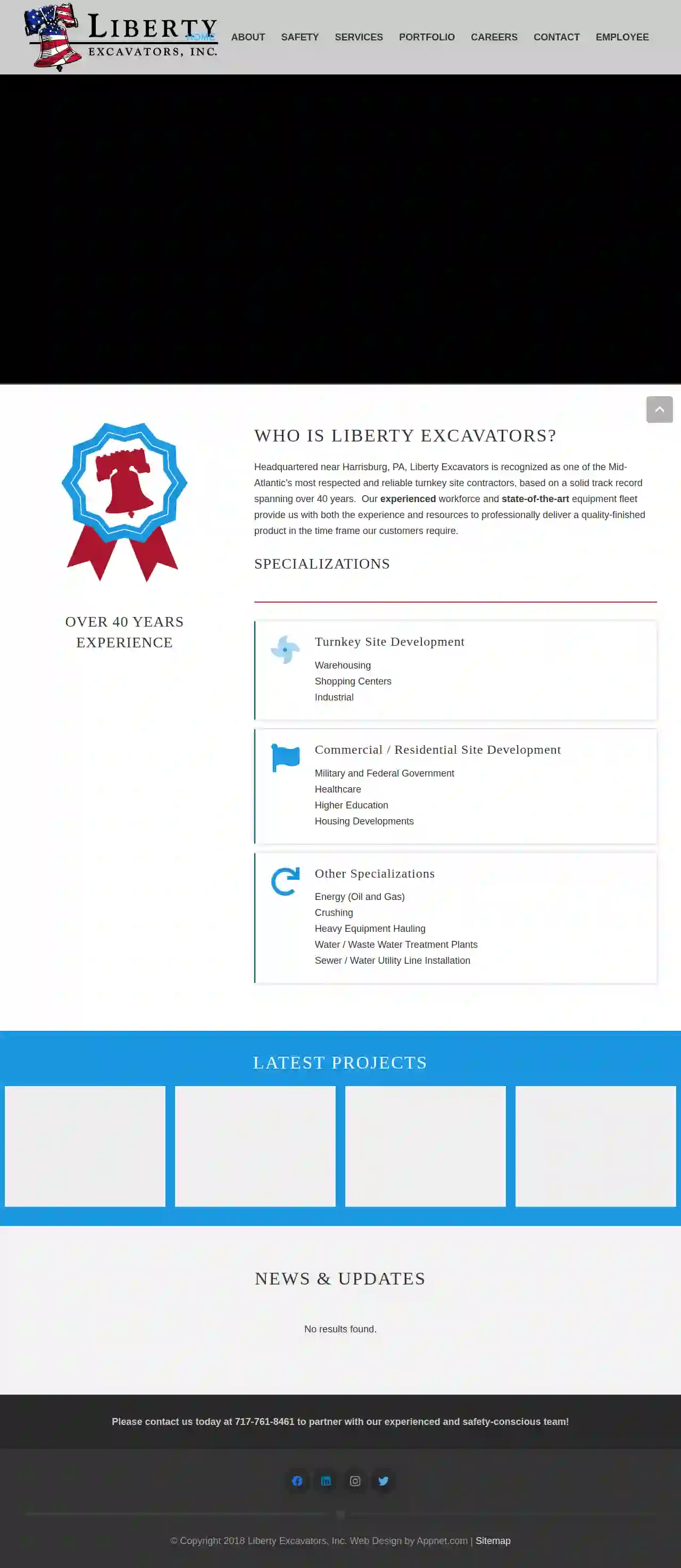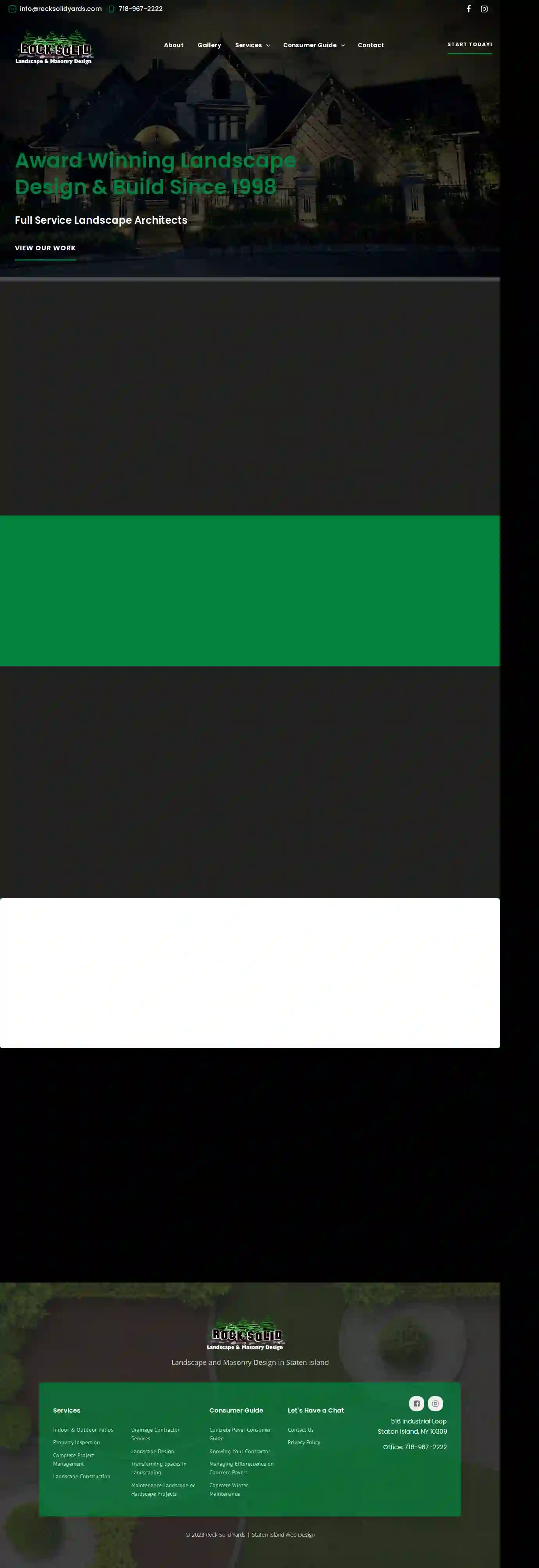Excavation Contractors Dorneyville
Find the best Excavating Contractors in Dorneyville
Get 3 FREE Excavation Contractor quotes for your project today! Compare profiles, reviews, accreditations, portfolio, etc... and choose the best deal.

Liberty Excavators Inc
3.123 reviewsHarrisburg, USWho is Liberty Excavators? Headquartered near Harrisburg, PA, Liberty Excavators is recognized as one of the Mid-Atlantic’s most respected and reliable turnkey site contractors, based on a solid track record spanning over 40 years. Our experienced workforce and state-of-the-art equipment fleet provide us with both the experience and resources to professionally deliver a quality-finished product in the time frame our customers require. Specializations Liberty Excavators specializes in a wide range of projects, including: Turnkey Site Development Warehousing Shopping Centers Industrial Commercial / Residential Site Development Military and Federal Government Healthcare Higher Education Housing Developments Energy (Oil and Gas) Crushing Heavy Equipment Hauling Water / Waste Water Treatment Plants Sewer / Water Utility Line Installation
- Services
- Why Us?
- Gallery
Get Quote
William Lawrence Excavating & Trucking
4.36 reviewsScranton, USAbout William Lawrence Excavating & Trucking William Lawrence Excavating and Trucking Company is a locally owned and operated business serving both residential and commercial clients in Montrose, PA for over 35 years. We take pride in our modern and well-maintained equipment, operated by a qualified, courteous, and reliable crew. Our commitment to safety is reflected in our fully insured operations. Whether you're planning a large or small project that requires excavating or trucking services, we offer free assistance in the planning stage and a free evaluation to help you find the most cost-effective methods available. We believe in delivering exceptional service and ensuring your project is completed to the highest standards. At William Lawrence Excavating & Trucking, we stand by our motto: "If We Start It…We Complete It!"
- Services
- Why Us?
- Gallery
Get Quote
Roto-Rooter Plumbing & Water Cleanup
4.7201 reviewsHarrisburg, USYour Local Roto-Rooter Plumber in Harrisburg, PA When you need a dependable plumber in Harrisburg, PA, look no further than Roto-Rooter. Our skilled local technicians have the training, experience, and cutting-edge tools to handle any plumbing issue. From routine maintenance to emergency repairs, we’ll tackle your most challenging plumbing problems swiftly and effectively. Plumbing emergencies can strike anytime, so we offer 24/7 service, 365 days a year, including holidays. When you call Roto-Rooter of Harrisburg, you can expect: Same day service 24/7 availability No hidden or extra charge for plumbing or drain service on holidays, nights, and weekends Free onsite and upfront estimates Professional, experienced plumbers State-of-the-art diagnostics and equipment Senior and military discounts Coupons and financing options At Roto-Rooter, your plumbing needs are our top priority. More people depend on us than any other plumbing company in North America. Our commitment to excellence ensures we address your plumbing issues promptly and correctly to keep your systems running smoothly. Don’t let plumbing problems disrupt your life. Call us at 7
- Services
- Why Us?
- Testimonials
- Gallery
Get Quote
Brubacher Excavating Inc
4.561 reviews825 Reading Road, P.O. Box 528, Bowmansville, 17507, USAt the heart of our company are hundreds of team members who apply decades of experience to deliver Insight. On Site in service our clients and communities as we live out our mission of Shaping the World We Live In. Their character, commitment, and expertise combined with our integrated services and industry-leading fleet ensure we deliver quality results from start to finish. As an excavating company who proudly serves partners across Pennsylvania, Maryland and Delaware, we provide specialized industry expertise to deliver total client satisfaction. You can count on our team to work safely and efficiently and to get the job done right on time, every time. Our Core Values At Brubacher, we honor our core values as a team in the decisions we make, results we deliver, and experiences we provide. Safety Because Life Matters Integrity Do What Is Right Initiative Make It Happen Teamwork Better Together
- Services
- Why Us?
- Gallery
Get Quote
USA Asphalt Paving Contractors
4.559 reviews3 N Line Rd, Newtown Square, 19073, USUSA Asphalt Paving Contractors: Your Trusted Paving Partner in Chester and Delaware Counties PA We understand that your driveway, parking lot, or sidewalk can be a source of frustration when they're cracked, faded, or uneven. That's why we're here to provide you with the solutions you need. We're a team of experienced paving contractors in Delaware County and Chester Counties PA, dedicated to delivering high-quality workmanship, competitive pricing, and exceptional customer satisfaction. With over 20 years of experience serving Delaware County, Chester County, Montgomery County, and beyond, we've earned a reputation for excellence. Our commitment to quality and professionalism has been recognized by leading consumer organizations. We're not just a paving contractor; we're your paving partner. We're here to help you with any paving, asphalt, or concrete services you need, making your life easier, your property safer, and your curb appeal higher. Don't settle for less. Why Choose USA Asphalt Paving Contractors? You have options, but not all paving contractors are created equal. Inexperienced contractors, unlicensed professionals, and uninsured companies can cost you time, money, and property. We understand the importance of choosing a reliable and trustworthy partner for your paving needs. At USA Asphalt Paving Contractors, we're experienced, licensed, and insured, with years of industry know-how. We're quality-oriented and competitively priced, ensuring you get the best value for your investment. We're detail-oriented experts who prioritize safety while delivering beautiful results. Don't risk your hard-earned cash on just anyone; trust the best when it comes to asphalt paving. Our Services We're your one-stop shop for all your asphalt, pavement, and concrete needs. We have the expertise and equipment to handle any size project, from small driveways to major roadways. Our comprehensive services include: Asphalt paving for driveways, parking lots, private roads, and more. We'll install, repair, or replace any asphalt surface you have, creating smooth, durable, and attractive surfaces that will last for years. Masonry and brickwork for walls, fireplaces, chimneys, and more. We can build, repair, or restore any masonry or brickwork, adding value and charm to your property. Concrete services for sidewalks, curbs, patios, and more. We'll install, repair, or replace any concrete surface, creating strong, stable, and versatile surfaces for any purpose. We can customize our services to fit your specific needs and preferences. We can also integrate certain services to create a comprehensive package for your project. We'll provide you with our honest assessment and recommendations to ensure you get the best possible results. Choose USA Asphalt Paving Contractors for guaranteed results at a price you can agree with!
- Services
- Why Us?
- Gallery
Get Quote
Shiloh Paving & Excavating, Inc.
3.77 reviews300 Cloverleaf Road, York, 17406, USShiloh Paving and Excavating: Your Trusted Partner for Quality Paving in York County, PA Shiloh Paving and Excavating has been serving the York County community since 1957. We are a family-owned and operated business with a commitment to providing exceptional service and exceeding customer expectations. Our team of experienced professionals is dedicated to delivering high-quality paving solutions for a wide range of projects, from residential driveways to commercial parking lots. We understand that your project is unique, and we take a personalized approach to ensure that your needs are met. We work closely with you throughout the entire process, from initial consultation to project completion, to ensure your satisfaction. At Shiloh Paving, we believe in building lasting relationships with our clients. We are committed to providing transparent pricing, timely completion, and exceptional customer service. We are proud to be a trusted partner for all your paving needs. Our Mission Statement "Whatever it Takes" We do "Whatever it Takes" through our team approach to provide excellent service and an outstanding customer experience.
- Services
- Why Us?
- Testimonials
- Gallery
Get Quote
RR Plumbing Roto-Rooter
4.8978 reviewsStaten Island, USStaten Island Plumbers Near You Plumbing & Drain Solutions: Licensed Staten Island Plumber Providing 24/7 Emergency Plumbing and Drain Services If you are currently looking for a reputable plumber in Staten Island that can meet your plumbing needs quickly and correctly the first time, then look no further. For over 85 years, RR Plumbing Roto-Rooter has been skillfully meeting the plumbing and drain cleaning needs of homes and businesses throughout the entire Staten Island, NY area. Our licensed and insured plumbers can handle commercial, residential, and emergency plumbing and drain cleaning needs of all sizes and complexities, including toilet repairs, blocked sinks, clogged shower drain repairs, sump pump replacements, and water heater installations. Our affordable plumbing services are also available 24/7 so that you do not have to wait to get the solutions you need.
- Services
- Why Us?
- Testimonials
- Gallery
Get Quote
Skiles Excavating, Inc.
46 reviews71 Smith Road, Newville, 17241, USSkiles Excavating: A Legacy of Precision and Community Skiles Excavating began its journey like many other successful excavating companies—with a single individual, James Skiles, who brought with him over 20 years of equipment operating experience, a backhoe, and an ambitious dream. In 2006, he created a business that would not only shape a better life for his family but also excel in the excavation industry. Since then, we’ve made significant strides, building strong relationships with electrical contractors while undertaking excavating projects for underground utilities and concrete work. Our services quickly expanded to include plumbing excavation and small site projects, enabling us to diversify our expertise. In 2018, we achieved the milestone of incorporation in Pennsylvania and are now proud to have a dedicated team of over 30 skilled employees. Our commitment to excellence and solid partnerships with contractors are the cornerstones of our success. One of our core values at Skiles Excavating is "Giving Back to the Community"— 1st Annual Shippensburg Pumpkin Festival
- Services
- Why Us?
- Gallery
Get Quote
I & I Excavating Inc.
57 reviewsNiagara, USHistory Welcome to I and I Excavating Inc, your premier destination for exceptional excavation and concrete services. Boasting over three decades of industry experience, our skilled team of professionals is devoted to delivering top-notch solutions tailored to your concrete needs. Catering to both homeowners and business owners, our comprehensive suite of services includes concrete driveways, sidewalks, patios, and innovative drainage solutions. At I and I Excavating Inc, we distinguish ourselves by consistently delivering outstanding results for every project we undertake. We invest the time to thoroughly comprehend your objectives and aspirations, collaborating closely with you to craft a bespoke solution that aligns with your distinct specifications. Our meticulous attention to detail and unwavering commitment to quality differentiate us from our competitors, and we assure your utmost satisfaction with the final outcome. So, what makes I and I Excavating Inc the ideal choice for your upcoming project? Our team of seasoned experts is dedicated to providing dependable, efficient, and cost-effective services. We utilize only the best materials, taking immense pride in our craftsmanship. Furthermore, our steadfast commitment to exceptional customer service ensures that we are always available to address your queries and concerns. Choose I and I Excavating Inc for a seamless and satisfying experience that exceeds expectations.
- Services
- Why Us?
- Testimonials
- Gallery
Get Quote
Rock Solid Landscaping and Masonry Design, Inc
3.723 reviews516 Industrial Loop, Staten Island, 10309, USAward winning landscape design & build since 1998 Full Service Landscape Architects Award winning landscape design & build since 1998 Full Service Landscape Architects Award winning landscape design & build since 1998 Full Service Landscape Architects Rock Solid Landscape and Masonry Design Inc specializes in designing and creating your dream home. Being experts in both hardscape and landscape design in Staten Island, we will help build the concept from your vision and ideas, and bring them to life. From start to finish, we work together with each of our clients to ensure that the work that is being done matches the concept that they dreamed up. Let Rock Solid Landscape and Masonry Design Inc create your next landscape masterpiece. Rock Solid Yards is the winner of Two 2010 Staten Island Chamber of Commerce Building Awards for: ROCK SOLID LANDSCAPE AND MASONRY DESIGN INC. more about us Serving the Tri-State area since 1998. MICHAEL IZZO OWNER/MASTER DESIGNER Michael Izzo has over 20 years of Landscape and Masonry Construction experience. He built Rock Solid Landscape and Masonry Design, Inc. from the ground up and he attributes his success to practicing good old fashioned business ethics and promoting a company philosophy of “exceeding customer expectations”. “Customers will return to and promote a business that consistently shows up and delivers exceptional quality projects on schedule and on budget. It’s really that simple.” Trust us for your masonry design and landscaping in Staten Island
- Services
- Why Us?
- Our Team
- Testimonials
- Gallery
Get Quote
Over 22,076+ Excavation Contractors on our platform
Our excavation providers operate in Dorneyville & beyond!
ExcavationHQ has curated and vetted the Best Excavation Contractors near Dorneyville. Find a top & reliable contractor today.
Frequently Asked Questions About Excavation Contractors
- Hauling to Designated Disposal Sites: Transporting excavated material to approved landfills or recycling centers.
- Recycling or Reuse: If suitable, some excavated soil might be recycled for other projects or reused on-site for landscaping or backfilling.
- Complying with Regulations: Adhering to local and environmental regulations for soil disposal to prevent contamination or illegal dumping.
- Clearly Define the Scope: Outline the project's goals, including the excavation area, depth, grade, and intended use.
- Obtain Necessary Permits: Research and acquire any required permits from your local authorities.
- Mark Utility Lines: Contact your utility companies to locate and mark underground utilities to prevent damage.
- Communicate with Neighbors: Inform your neighbors about the project's timeline and potential noise or disruptions.
- Prepare the Site: Clear any obstacles, such as vegetation, furniture, or structures, from the excavation area.
- Discuss Safety Protocols: Review safety procedures with the contractor to ensure a safe work environment.
- Experience: Choose contractors with a proven track record and years of experience in excavation projects similar to yours.
- Licensing and Insurance: Verify that they are properly licensed to operate in your area and carry adequate insurance to protect you from liability in case of accidents or damage.
- Equipment and Resources: Ensure they have the necessary equipment and resources to handle your project efficiently and safely.
- Positive Reviews and References: Check online reviews and testimonials from previous customers. Request references and contact them to inquire about their experience with the contractor.
- Professionalism: Opt for a company that communicates clearly, provides detailed and transparent estimates, and has a responsive and courteous team.
How do you handle soil disposal after excavation?
What should I do before excavation starts?
How do I find a good excavation contractor?
What is the difference between cut and fill excavation?
Cut: Involves excavating soil from an area where the existing grade is higher than the desired grade.
Fill: Refers to using the excavated soil ('cut' material) to raise the grade in an area where the existing grade is lower than desired.
This method minimizes the need to import or export soil, reducing costs and environmental impact. It's commonly used for site preparation, road construction, and landscaping.
How do you handle soil disposal after excavation?
- Hauling to Designated Disposal Sites: Transporting excavated material to approved landfills or recycling centers.
- Recycling or Reuse: If suitable, some excavated soil might be recycled for other projects or reused on-site for landscaping or backfilling.
- Complying with Regulations: Adhering to local and environmental regulations for soil disposal to prevent contamination or illegal dumping.
What should I do before excavation starts?
- Clearly Define the Scope: Outline the project's goals, including the excavation area, depth, grade, and intended use.
- Obtain Necessary Permits: Research and acquire any required permits from your local authorities.
- Mark Utility Lines: Contact your utility companies to locate and mark underground utilities to prevent damage.
- Communicate with Neighbors: Inform your neighbors about the project's timeline and potential noise or disruptions.
- Prepare the Site: Clear any obstacles, such as vegetation, furniture, or structures, from the excavation area.
- Discuss Safety Protocols: Review safety procedures with the contractor to ensure a safe work environment.
How do I find a good excavation contractor?
- Experience: Choose contractors with a proven track record and years of experience in excavation projects similar to yours.
- Licensing and Insurance: Verify that they are properly licensed to operate in your area and carry adequate insurance to protect you from liability in case of accidents or damage.
- Equipment and Resources: Ensure they have the necessary equipment and resources to handle your project efficiently and safely.
- Positive Reviews and References: Check online reviews and testimonials from previous customers. Request references and contact them to inquire about their experience with the contractor.
- Professionalism: Opt for a company that communicates clearly, provides detailed and transparent estimates, and has a responsive and courteous team.
What is the difference between cut and fill excavation?
Cut: Involves excavating soil from an area where the existing grade is higher than the desired grade.
Fill: Refers to using the excavated soil ('cut' material) to raise the grade in an area where the existing grade is lower than desired.
This method minimizes the need to import or export soil, reducing costs and environmental impact. It's commonly used for site preparation, road construction, and landscaping.